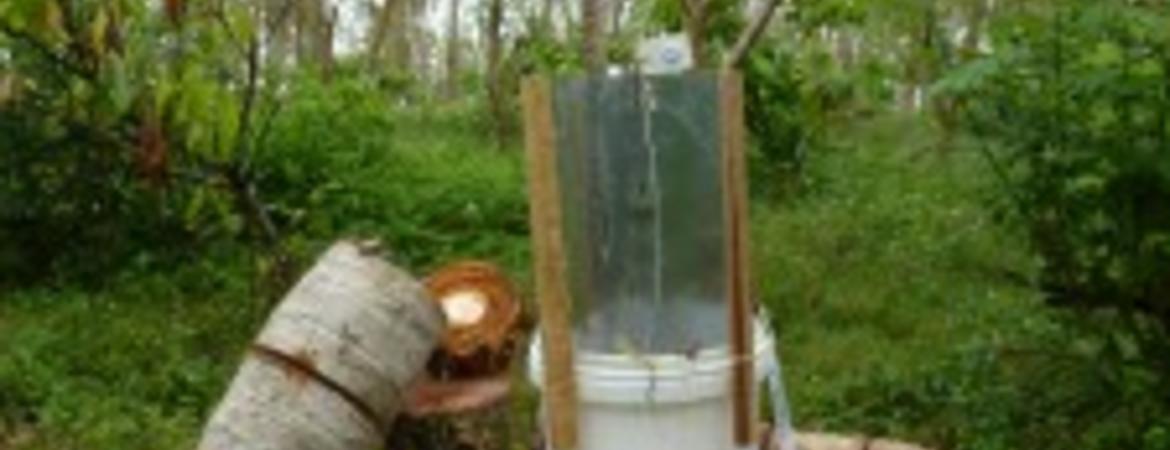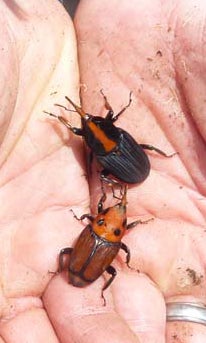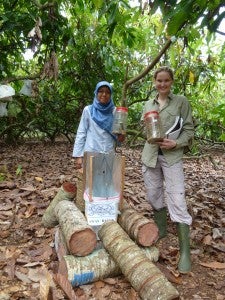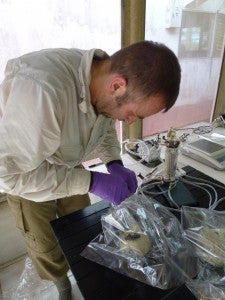
Since the first official detection of red palm weevil (RPW) in September 2010, the California Department of Food and Agriculture has been running a pheromone trapping program for this pest in Laguna Beach. As part of this trapping program, CDFA is monitoring 153 traps that are set up in two different patterns. The core area around the initial RPW finds is being trapped at a rate of 50 traps per square mile. Outside of this intensive trapping area the remaining traps are deployed at 25 per square mile. Traps were monitored weekly until March 2012, after this time, servicing has been reduced to once every two weeks. The first RPW adult caught as part of this monitoring program was collected from a trap on 18 January 2012 that was last serviced 9 January 2012. The trap that caught the single RPW was on a Washingtonia palm close to the Pacific Coast Highway in Laguna Beach.
It is surprising that despite the intensive and long-term trapping effort by the CDFA that so few RPW have been trapped. In overseas countries were RPW is either native (e.g., India) or invasive (e.g., the Mediterranean and Saudi Arabia) the pheromone traps are very effective at luring and trapping RPW. However, it should be noted that the color form of the RPW caught in these trapping programs is the orange and black form, and not the red stripe form that is present in Laguna Beach.

There could be several reasons for the lack of RPW captures in Laguna Beach using the pheromone bucket traps:
- The RPW pheromone that is being used in the trapping program, while very attractive to the orange and black form RPW, is not particularly attractive to the red stripe form in Laguna Beach. May be it is not even the correct aggregation pheromone.
- Densities of RPW in Laguna Beach are simply too low to be captured in the bucket traps with the pheromone.
- The pheromone trap set up being used is not very attractive to the red stripe form of RPW in Laguna and dispersing RPW simply ignore it because they find infested palm trees more attractive and they tend to aggregate here with other RPW instead of going to the traps.
To address these potential issues a couple of research projects were executed overseas with funding from the CDFA’s Specialty Crops Program. This program was designed to investigate possible factors affecting the success of the trapping program in Laguna Beach, and if possible, to figure out ways to make it more effective.
Three key research questions were addressed with research projects that were run in the Philippines and Indonesia: (1) can the commercially-available RPW pheromone that is being used in Laguna Beach attract the red stripe form of RPW in countries where this color form is native? We had to do the work in these overseas countries because there are no other areas in the world which have the red stripe form of RPW. (2) Is there a more attractive trap set up that could increase the chances of capturing the red stripe form of RPW? (3) Does the pheromone for the red stripe form of RPW have the same chemical make up as the commercial RPW pheromone used for trapping the orange form of RPW?
Assessing the Attractiveness of the RPW Trapping Program Used in Laguna Beach to the Red Stripe Form of RPW. Two large field experiments were conducted in the Philippines and Sumatra Indonesia to assess the attractiveness of the CDFA’s bucket trap to the red stripe form of RPW. Three different trap set ups were tried: (A) cut coconut logs only (coconuts are a highly preferred host palm for RPW in countries where it is native and volatiles released from cut coconut palms are very attractive to RPW), (B) pheromone traps only, and (C) pheromone traps with freshly cut coconut logs.

The results of these trials in the Philippines and Indonesia were crystal clear – RPW was highly attracted to stacks of cut coconut palm logs that had the pheromone traps sitting on the log stack. This suggested to us that perhaps the missing element in Laguna was a lack of freshly cut palm material to help attract RPW to the pheromone traps that the CDFA is using to monitor for this pest.
The results of this study also indicated that the commercially-available pheromone seemed to be quite important for attracting the red stripe form of RPW to stacks of cut coconut logs. But did this mean that the pheromone was actually the correct one used by the red stripe form, or did these RPW simply find it O.K., but not as attractive as the pheromone that they produce themselves (assuming the red stripe RPW have a similar but different pheromone to that used by the orange and black forms)? To answer this question we collected aggregation pheromone for red stripe RPW captured in the field in an oil palm plantation in Sumatra Indonesia.

Collecting Aggregation Pheromone from the Red Stripe Form of RPW in Sumatra Indonesia. Adult red striped RPW collected from oil palm trees that had collapsed in a commercial oil palm plantation were used for the pheromone collection experiments. The process was quite simple in concept, but a little challenging to execute in an outdoor shed in an oil plantation! Field collected RPW (all red stripe forms) were set up in oven bags that had hoses hooked up to an aquarium pump. The aquarium pump pulled air through a special set of filters to remove any potential volatile contaminants before it passed into the oven bags and over the contents of the bags. The RPW were contained in mesh cages inside the oven bags so they couldn’t chew holes in the bags and escape. Four oven bags were set up each time pheromone aeration trials were run. The bags contained either an empty sterilized mesh cage (to capture the chemical signature of the mesh cage), RPW food only in a mesh cage.

Sugar cane or oil palm hearts were the food used for the RPW – it really likes to eat both types, but we didn’t know whether sugar cane or oil palm would be needed to stimulate RPW to release aggregation pheromone, so we tried both. RPW in a mesh cage only, or RPW with food inside a mesh cage. Aerations were made for these different treatments continuously for about 3-4 days. The volatiles released were trapped on ultra-pure charcoal filters as purified air was pulled through the oven bags containing the treatments. After this exposure time the charcoal filters were removed, new treatments were set up again, and then randomly assigned to a new set of oven bags. The process was repeated three or four times over a 14 day period.

The charcoal filters with aeration product were air expressed from Sumatra to Riverside, California. Jocelyn Millar at UC Riverside analyzed the aggregation pheromone captured on the charcoal filters that had been released from the red stripe RPW inside the oven bags. Millar’s analyses clearly showed that the aggregation pheromone released by the red stripe form in Sumatra was exactly the same as the commercially-available pheromone used to trap the orange and black form of RPW. We concluded from this work that we were using the correct aggregation pheromone to attract the red stripe form of RPW in Laguna Beach.
A New Trapping Plan for the Red Striped RPW in Laguna Beach. So after the completion of these studies in the Philippines and Indonesia, the pieces were now in place to consider a modified trapping program for the red stripe RPW in Laguna. We know that the aggregation pheromone released by the red stripe RPW is exactly the same as the commercially-available pheromone used to trap the orange and black form of RPW, so there is no problem in using this pheromone. We also learned that red stripe RPW are strongly attracted to stacks of freshly cut palm logs that have aggregation pheromone sitting on top of these log stacks. The challenge after figuring this out is to replicate this set up in Laguna Beach.

The CDFA gave permission to set up a new trapping plan in May 2012 using freshly cut date palm logs and pheromone traps. This program was a replication of the successful trapping programs that had been tested in the Philippines and Indonesia. In June 2012, three stacks of cut date palm logs with RPW pheromone traps were deployed at three different sites in Laguna Beach. This project was a major collaboration between UC Riverside with date palm producers in the Coachella Valley, in particular Duane Young with Cocopah Nurseries in Indio California, and Albert Keck with Hadley Dates in Vista Santa Rosa (both businesses operate out of the Coachella Valley.)
Cocopah Nurseries donated 3 date palms that were felled, and from which the top most third was removed from the trunk and cut with a chainsaw into sections for deployment at Laguna Beach. These palm sections were transported to Laguna Beach and set up at three different sites with pheromone traps. These sites were selected based on their close proximity to previous find sites for RPW and to palms which have had evidence of recent RPW attacks. The log stacks and pheromone buckets are checked daily and trap checking is a cooperative effort between CDFA (Mohammed Alzubaidy), the Orange County Agricultural Commissioner’s Office (Nick Nisson), UC Cooperative Extension (John Kabashima), and UC Riverside (Mark and Christina Hoddle). At the time this blog was written, this new trapping program had been out for one week and no RPW had been caught.